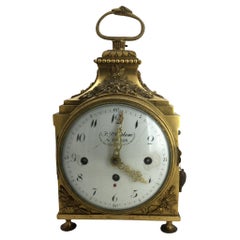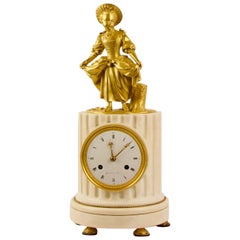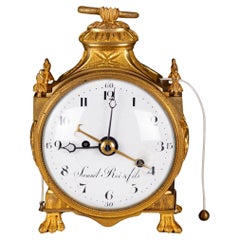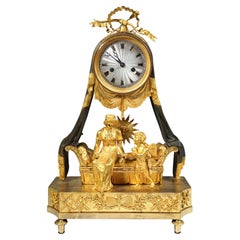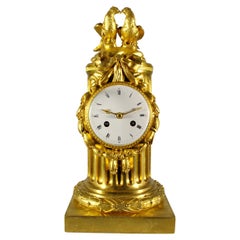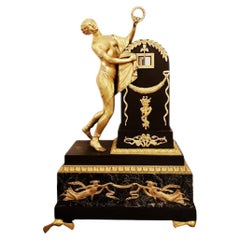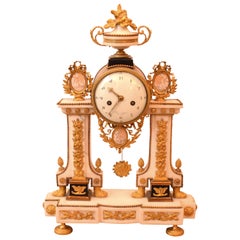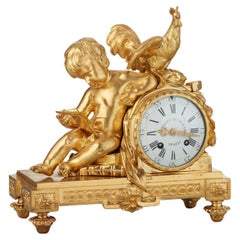Pendule Louis Xvi
Antique Late 18th Century French Louis XVI Carriage Clocks and Travel Cl...
Ormolu
Antique 1770s French Louis XVI Mantel Clocks
Carrara Marble, Enamel, Bronze
Antique Late 18th Century French Louis XVI Carriage Clocks and Travel Cl...
Ormolu
Antique 1790s French Louis XVI Table Clocks and Desk Clocks
Bronze
Antique 1870s French Louis XVI Mantel Clocks
Carrara Marble, Ormolu
Antique Late 18th Century French Charles X Mantel Clocks
Bronze
Antique 19th Century French Empire Mantel Clocks
Marble, Metal, Bronze, Enamel, Ormolu
Antique 18th Century French Louis XVI Table Clocks and Desk Clocks
Marble, Bronze
Antique 18th Century French Mantel Clocks
Bronze, Ormolu
Antique Mid-18th Century French Louis XVI Mantel Clocks
Marble
Antique 18th Century French Louis XVI Table Clocks and Desk Clocks
Wood
Antique 18th Century French Louis XVI Mantel Clocks
Bronze
Antique 18th Century French Louis XVI Mantel Clocks
Bronze
Antique 19th Century French Louis XVI Clocks
Ormolu
Antique 18th Century and Earlier French Louis XVI Clocks
Marble, Ormolu
Antique 18th Century Mantel Clocks
Marble, Bronze
Antique 1860s French Louis XVI Table Clocks and Desk Clocks
Bronze
Antique 1880s French Louis XVI Mantel Clocks
Ormolu, Bronze
Antique Late 18th Century French Louis XVI Mantel Clocks
Marble, Bronze, Enamel
Antique Late 18th Century French Louis XVI Table Clocks and Desk Clocks
Marble, Bronze
Antique Late 18th Century French Louis XVI Mantel Clocks
Marble, Bronze
Antique Late 18th Century French Louis XVI Mantel Clocks
Marble, Bronze
Antique Late 18th Century French Louis XVI Mantel Clocks
Marble, Bronze
Antique 1780s French Louis XVI Mantel Clocks
Marble, Bronze
Antique 1770s French Louis XVI Mantel Clocks
Marble, Bronze
Antique 1780s French Louis XVI Mantel Clocks
Carrara Marble, Enamel, Ormolu
Antique Early 19th Century French Empire Mantel Clocks
Marble, Bronze, Enamel
Antique Late 19th Century French Louis XVI Mantel Clocks
Ormolu
Antique 1880s French Louis XVI Mantel Clocks
Bronze, Ormolu
Antique Late 19th Century French Louis XVI Table Clocks and Desk Clocks
Ormolu
Antique 19th Century French Louis XV Mantel Clocks
Marble, Bronze, Ormolu
Antique 1880s French Louis XVI Carriage Clocks and Travel Clocks
Ormolu
Antique Late 18th Century French Louis XVI Table Clocks and Desk Clocks
Antique 18th Century and Earlier French Louis XVI Clocks
Ormolu
Antique 18th Century French Louis XVI Table Clocks and Desk Clocks
Marble, Bronze
Antique 19th Century French Napoleon III Carriage Clocks and Travel Clocks
Bronze, Ormolu
Pendule Louis Xvi For Sale on 1stDibs
How Much is a Pendule Louis Xvi?
A Close Look at Louis Xvi Furniture
Reflecting the final era of royal opulence before the upheaval of the French Revolution, antique Louis XVI furniture features more angular shapes than the Rococo curves of the Louis XV style, harkening back to the imposing grandeur of Louis XIV.
Dating between 1750 and 1800, an era that overlapped with the last king of France whose reign was cut short by the guillotine, Louis XVI furniture, known as the goût grec, is emblematic of the neoclassical revision that French furniture underwent during the second half of the 18th century.
Authentic Louis XVI furniture characteristics include clean lines and carved details such as scrolls and acanthus flourishes that were inspired by ancient Greece and Rome. This was informed by a burgeoning interest in antiquity in the 18th century, owing to new archaeological excavations at sites including Pompeii and Herculaneum. It largely eclipsed the more East Asian–influenced ornamentation of Louis XV for something more geometric and symmetrical.
The Louis XVI style was defined by what was being created for the palatial rooms at Versailles and Fontainebleau, particularly for the queen, with cabinetmaker Jean-Henri Riesener being a favorite of Marie-Antoinette’s for his luxurious pieces accented with gilded bronze and marquetry. Furniture maker Jean-Baptiste-Claude Sené was also a major designer of the period, with his pieces for the royal residences adorned with giltwood and neoclassical touches like tapered columns for chair legs and laurel leaf carvings. Cabinetmaker Adam Weisweiler occasionally incorporated into his furniture porcelain panels produced by Sèvres, a popular manufacturer of European ceramics that served the crown with serveware, vases and other decorative objects.
Find a collection of antique Louis XVI seating, tables, cabinets and other furniture on 1stDibs.
Finding the Right Clocks for You
A sophisticated clock design, whether it’s a desk clock, mantel clock or large wall clock for your living room, is a decorative object to be admired in your home as much as it is a necessary functional element. This is part of the reason clocks make such superb collectibles. Given the versatility of these treasured fixtures — they’ve long been made in a range of shapes, sizes and styles — a clock can prove integral to your own particular interior decor.
Antique and vintage clocks can whisk us back to the 18th and 19th centuries. When most people think of antique clocks, they imagine an Art Deco Bakelite tabletop clock or wall clock, named for the revolutionary synthetic plastic, Bakelite, of which they’re made, or a stately antique grandfather clock. But the art of clock-making goes way back, transcending continents and encompassing an entire range of design styles and technologies. In short, there are many kinds of clocks depending on your needs.
A variety of wall clocks can be found on 1stDibs. A large antique hand-carved walnut wall clock is best suited to a big room and a flat background given what will likely be outwardly sculptural features, while Georgian grandfather clocks, or longcase clocks, will help welcome rainswept guests into your entryway or foyer. An interactive cuckoo clock, large or small, is guaranteed to bring outsize personality to your living room or dining room. For conversation pieces of a similar breed, mid-century modern enthusiasts go for the curious Ball clock, the first of more than 150 clock models conceived in the studio of legendary architect and designer George Nelson.
Minimalist contemporary clocks and books pair nicely on a shelf, but an eye-catching vintage mantel clock can add balance to your home library while drawing attention to your art and design books and other decorative objects. Ormolu clocks dating from the Louis XVI period, designed in the neoclassical style, are often profusely ornate, featuring architectural flourishes and rich naturalistic details. Rococo-style mantel clocks of Meissen porcelain or porcelain originating from manufacturers in cities such as Limoges, France, during the 18th and 19th centuries, exude an air of imperial elegance on your shelves or side tables and can help give your desk a 19th-century upgrade.
On 1stDibs, find a range of extraordinary antique and vintage clocks today.
- 1stDibs ExpertNovember 4, 2024To identify Louis XVI chairs, first familiarize yourself with the characteristics of the design style by looking at images found on trusted online resources. Often, Louis XVI chairs rest on straight, column-like legs, and their frames show off intricate carvings such as scrollwork rosettes, fluting and ribbon twists. Typically, chairs from the era have recessed arms connected to the front of the seat via an elegant curve. Artisans of the period typically constructed chairs in mahogany, walnut or oak wood. If your chair has these features, it will likely be an original Louis XVI piece or a reproduction based on one. To tell antiques apart from contemporary chairs, consider their overall condition.
Due to their age, originals will likely show some signs of wear, and you may be able to spot visible tool marks or slight irregularities in the carvings due to their handcrafted origins. A chair that looks unused and is completely uniform with no tool marks is less likely to be an original. When in doubt, check with a certified appraiser or experienced antique dealer.
On 1stDibs, find a selection of Louis XVI chairs.
